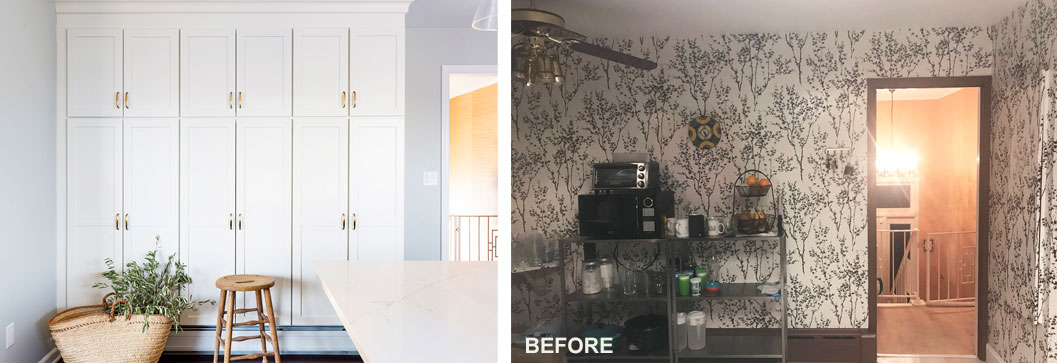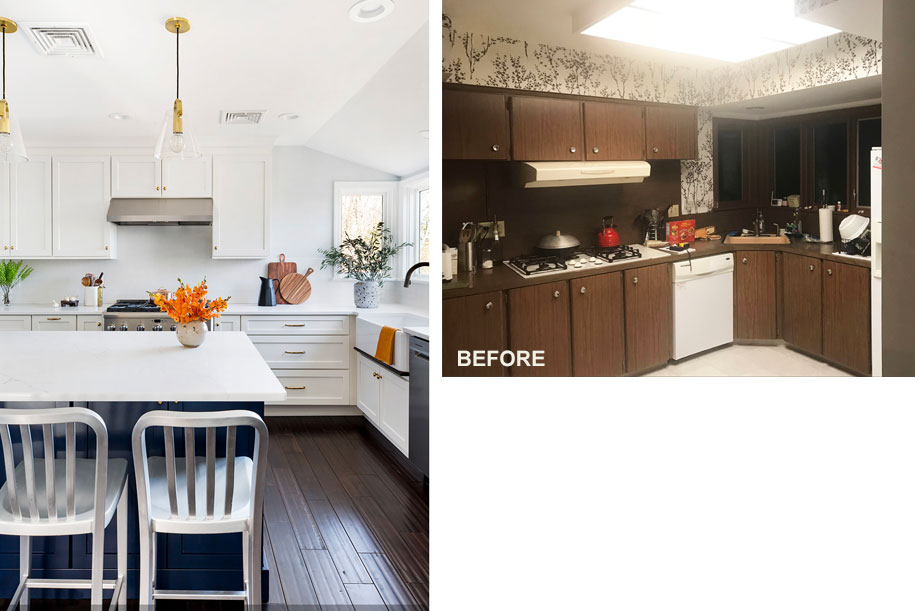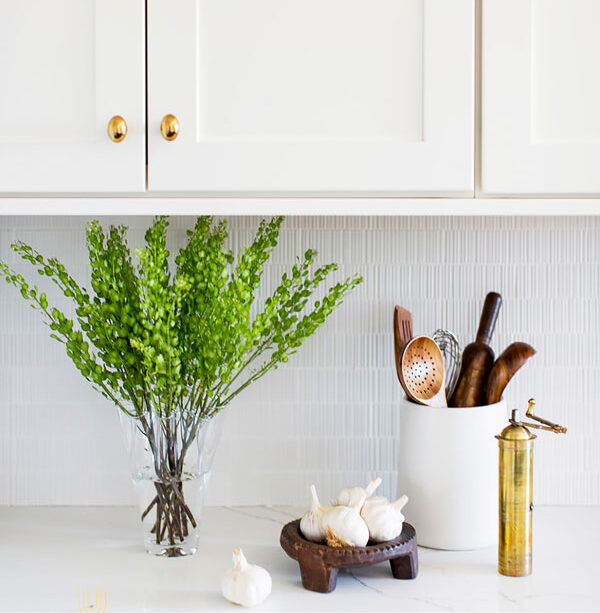Bon Appétit!
Writer Marirose Krall | Photographer Edward Underwood | Designer Shawna Underwood, Licensed Interior Designer, NCIDQ, LEED AP | Location West Orange, NJA Midcentury kitchen gets a dramatic revamp

“We wanted the new kitchen to be nice and clean, but also warm,” the homeowner says. “We wanted it to look like a home.” | BEFORE: The elevator in the original space was next to the refrigerator.
The existing kitchen in this circa-1961 West Orange, New Jersey, bi-level was certainly dated; just how dated was established one day when the homeowners were watching an episode of Julia Child’s cooking show (The French Chef debuted in 1963). “I think Julia had the same double oven that was in our kitchen,” the homeowner recalls. The ovens, along with the dark cabinets and linoleum floor, were likely original to the home. “The room definitely had character,” says Shawna Underwood, NCIDQ, LEED AP.

TOP LEFT: The new kitchen is airy and open. Clear pendants above the island accessorize the space without interrupting sight lines. TOP RIGHT: To the left of the double oven, the wallpaper covers a “hidden” spice rack. BOTTOM LEFT: The open spice rack in the old kitchen. BOTTOM RIGHT: Julia Child on the set of The French Chef, which debuted in 1963 with a very similar oven. Photograph by Paul Child. © Schlesinger Library, Radcliffe Institute, Harvard University, image number w539728_1
Clearly, it was time for a change. The homeowners asked Underwood, a friend from their college days who is now principal of Washington, D.C.-based Shawna Underwood Interior Design, to help with the transformation. “She was very excited,” says the homeowner, who appreciated that her friend “did not gasp” at the state of the kitchen.
There was no need for gasping; Underwood understood exactly how to update the room. The goal, she says, was to “open up the space and bring in more natural light. We wanted a clean, bright feeling, but also have a nod to the midcentury style of the home.” The homeowners wanted their new kitchen to be “nice and clean, but also warm.”
The first step toward creating that atmosphere was removing an elevator the previous residents had installed on the refrigerator wall and enlarging the opening between the kitchen and the dining room. Those changes immediately added space and light. White perimeter cabinets contribute to the airy feeling, but “we didn’t want it to feel sterile or cold,” Underwood says. So she added dark wood floors, walnut-stained floating shelves and brass cabinet hardware to bring depth and interest. Pendants above the island have brass accents that coordinate with the hardware, while their clear shades keep sight lines unobstructed. The island cabinetry, in classic navy blue, contributes a pop of color. “We didn’t want an all-white kitchen,” the homeowner says, “but we also wanted something that wouldn’t go out of date in five years.”

Floor-to-ceiling cabinets maximize storage. | BEFORE: Portable shelving units were a less-than-efficient use of space.
Texture comes in the form of the grooved, white backsplash tile. “They didn’t want standard subway tile,” Underwood explains. “They thought that was a little too plain. The tile we chose is simple and timeless, but has a ribbed texture that gives a nod to the midcentury vibe.”
Underwood also took into account the family’s practical needs, maximizing storage with drawers in the island and a built-in pantry on a formerly little-used wall. With two small children, the family takes full advantage of the floor-to-ceiling cabinetry.
The renovation process ran fairly smoothly, even in the midst a pandemic and given the fact the designer and her clients were separated by several states. “I visited prior to Covid to get measurements and photos,” Underwood says. “The plan was to travel back and forth during the design process.” Though the virus put a wrench in that plan, Underwood and the homeowners persisted, scheduling videoconferences at every stage of the project. “Once we were ready to go, we hit the ground running,” Underwood says. The homeowners remained in the house throughout the project, converting their garage into a makeshift kitchen with a convection cooktop, air fryer and microwave and washing up in the laundry room sink. “We mainly lived on the downstairs level. The kids learned all about watching TV while eating dinner,” the homeowner says with a laugh.
In spite of the complications, including supply chain issues that increased wait times for appliances, the entire project took only three months. That was a pleasant surprise for the homeowner, who’d witnessed countless construction horror stories on television. “I watch HGTV, so I expected it to take double that time,” she says.

Dark wood flooring and a navy blue island add warmth to the predominantly white space. | BEFORE: The installation of an elevator (wall at right) left a cramped space for fixtures such as the sink, dishwasher and range.
Though it’s now been months since it was revamped, the homeowner still has a soft spot for the original brown kitchen, and she’s kept a piece of the wallpaper as a souvenir. “We’ll have to incorporate it somewhere in the house,” she says. Underwood also harbors some affection for the retro wall covering. “I could definitely see it used today with more updated elements.”
The homeowner credits Underwood for interpreting her vision beautifully. “We had a general idea; Shawna is very good on the details. Even in video chats, she was able to pick up on things and ask important questions. That was the ease for me. She really listened and very much tailored it to what we as a family wanted.”
For more “Before & After” projects, see the June/July issue of Design NJ on newsstands now.

